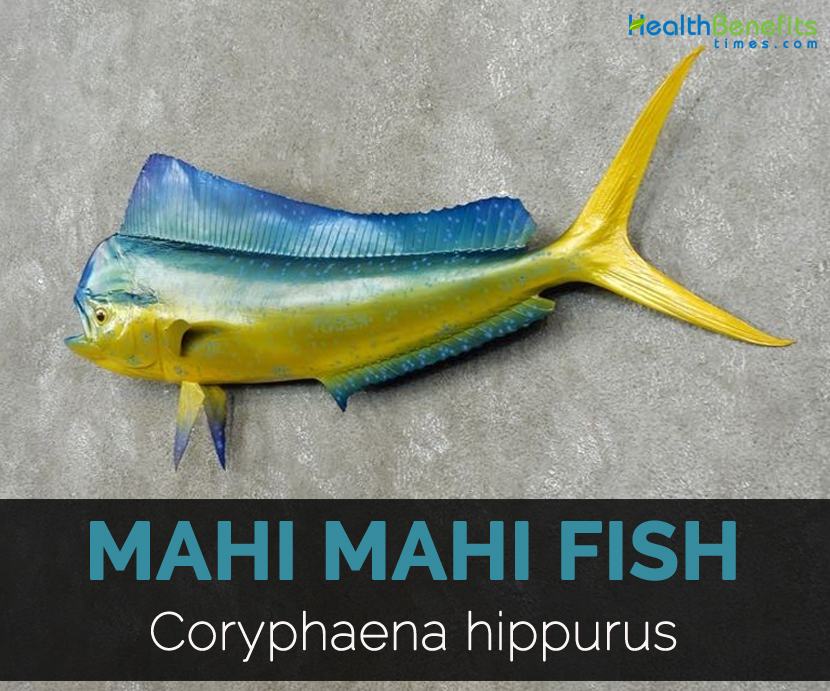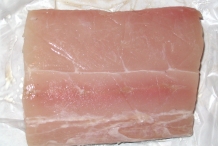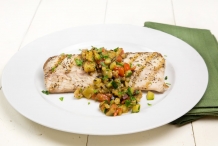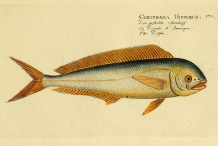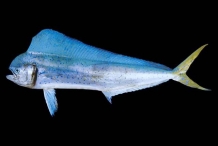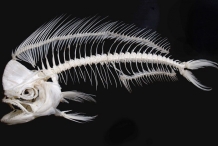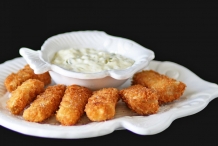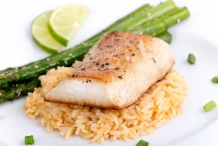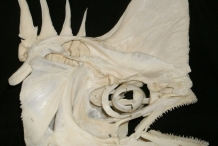Mahi Mahi has slender, long and tapered body that helps to swim at high speeds. The body and median fins has bands of pigment and pigmented pelvic fins laterally. Dorsal fin runs to the bright yellow caudal fin. It is bright blue to green dorsally and yellowish to white having pigments ventrally. A sexual dimorphism could be noticed after six months of age. In comparison to females, males are heavier and also physically larger. Usually, these fish measures 1 meter long but could also reach upto 2 meters. It weighs around 14 kg and the maximum recorded weight is 39.5 kg. Mahi Mahi is found in tropical, off-shore temperate and subtropical waters.
Description
This fish possess compressed bodies and a long based dorsal fin that extends from head to the tail. Males (mature) have prominent foreheads which protrude well above the body. Females have rounded head. Anal fins and caudal fins are concave sharply. It is characterized by dazzling colors: bright blues and greens on sides or back and golden on sides. It has iridescent blue pectoral fins and broad, golden flank. It has soft and oily flesh resembling sardines. Fish changes its color when out of the water going through several hues before fading to muted yellow-grey on death. Mahi-Mahi spawn in warm ocean currents throughout much of the year. Mostly it could be found in the surface water and could swim fast as 50 knots i.e. 92.6 km/h, 57.5 mph.
Reproduction
Males and females become sexually mature in their first year i.e. by 4-5 months old. When the body is 20 cm long, spawning occurs. Females might spawn two to three times per year and could produce from 80,000 and 1,000,000 eggs per event.
Feeding habits & habitat
Mahi Mahi chase small bait fish such as slimy mackerel and sauries. It is found in waters which are over 20 degrees Celsius.
Health Benefits of Mahi Mahi
Also known from the name as dolphinfish, this fish has high content of protein. One could obtain one ounce equivalent of protein from one ounce of Mahi Mahi. Each 3-ounce serving offers 93 calories when added to the diet. Mahi Mahi is considered to be the healthiest fish that promotes health with its nutritional value. This fish helps to lower the chances of heart problems, cancer, counteract inflammation, reduces signs of aging, maintain healthy nerves and cell functions.
Here are the health benefits discussed in detail that Mahi Mahi does to the body:
- Excellent Protein source
This is one of the top and foremost health benefits of Mahi Mahi. The presence of high level of protein promotes the healthy body tissues. In addition, it also contains essential amino acids which are good for the body. In order to fulfill protein requirements, one could add this fish to the meal. Protein is the crucial nutrient for the body. It assists in proper functioning of cells and overall metabolic rate of the whole body. The healthy metabolism assists in more efficient functions and also maintains healthy weight. Besides this, diet rich in protein is required for building and maintaining muscles.
- Adequate minerals
Another health benefit is the way to supply minerals. It has rich amounts of iron that assist in promoting red blood cells to carry oxygen to all parts of the body. The serving of 3-ounce Mahi Mahi fulfills 7 percent of daily requirement for women and 15 percent for men. An intake of Mahi Mahi fulfills the needs of iron as the deficiency of iron in the body leads to various health problems such as anemia.
It also offers minerals such as phosphorus, selenium and iron. Selenium provides antioxidant activity that assist immune function and thyroid gland. Magnesium promotes bone health, muscle and nerve function and also regulates cardiac rhythm. Phosphorus assist in energy production, improve bone health and forms cellular membranes.
- Presence of selenium
Mahi Mahi offers good amount of selenium and sodium. The consumption of Mahi Mahi serves 36.5 micrograms of the 55 micrograms of selenium and 88 milligrams of sodium. Selenium protects body from the damage of free radicals and sodium helps to balance body fluids.
- Source of B vitamins
It could not be denied that Mahi Mahi is a great source of B Vitamins such as Vitamin B-6, thiamin and riboflavin. Serving 3-ounce of Mahi Mahi provides 45 percent and 39 percent of daily recommended intake for women and men respectively of niacin or Vitamin B3. It assist in body metabolism.
- Healthy heart
Mahi Mahi is a good source of omega-3 fatty acids which is a type of polyunsaturated fat. Omega-3 has extensive health benefits such as cutting down inflammation and lowers the chances of heart problems. Add Mahi Mahi to the diet to promote the nutritional value. Too much inflammation exacerbates autoimmune disorders in the body such as asthma, lupus and Ulcerative Colitis. Moreover, inflammation causes growth of tumor in the body and could be a risk factor for heart attack, heart disease and stroke. Addition of Omega-3 to the diet reduces the chances of complications. Omega-3 fatty acids lower triglycerides levels, blood pressure, arrhythmia and atherosclerosis.
- Healthiest option
The addition of Mahi Mahi is the smartest choice to have a healthy diet. Mahi Mahi consists of low calories.
- Enhance metabolism
Mahi Mahi is a good source of Vitamin B-5. The serving size of 6-ounces helps to obtain 1.3 milligrams of Vitamin B-5 that assist in enhancing metabolism.
- Assist brain functions
The presence of Vitamin B-6 helps to promote brain functions that help to promote the activity of neurotransmitters as a control of neurological processes. The consumption of 6-ounce serving of Mahi Mahi grants 0.7 milligrams of Vitamin B-6 i.e. 54% of daily recommended intake of Vitamin B-6.
How to Eat
- Mahi Mahi could be grilled and baked with pepper.
- Steam Mahi Mahi with olive oil and lemon juice.
- Add it to the salad.
- It could also be broiled, sautéed and baked.
- Use it in soups.
- Having mild flavor, it works well with Caribbean & Pacific Rim spices.
Storage
- Store fresh Mahi-mahi tightly wrapped in the coldest part of refrigerator for 3 to 4 days.
- If properly wrapped and bagged, Mahi Mahi freezes well and keep for several months.
- Store it in the ice or refrigerator or freezer immediately after bought.
- Fish fillets or steaks should be vacuum packaged to prevent off flavors or freezer burn. Instead of vacuum packaging, one could use moisture/ vapor proof plastic wrap or heavy duty freezer bags. Place fillet in a plastic wrap individually without adding water. Discard as much air as possible from the freezer bag. Then freeze it by adding ice.
Purchasing Tips
- Mahi Mahi should not feel mushy or smell fishy. Choose moist, resilient fillets or steaks having a fresh and almost neutral scent.
- Whether fresh or frozen, it is pink with red stripes or spots and occasionally light brown or bluish tinges.
- Avoid fish having a dull color or dark brown areas along the edges, as it indicates the beginning of spoilage. Dark red blood lines and spots are ok but before cooking, it should be trimmed before for a milder flavor.
- Skin should be shiny and moist-looking not dry or lifeless. The color of skin can range from silver to dark gray having small black spots and yellow or golden streaks.
Precautions
- Seafood should be cooked safely in order to prevent foodborne illness.
- Avoid consuming it raw.
- Pregnant women, young children, older adults, people having lower stomach acid and compromised immune systems (HIV/AIDS, liver disease, cancer, diabetes, gastrointestinal disorders, people taking steroids, chemotherapy or immune system) are prone to higher risk.
- It might be contaminated with bacteria such as Vibrio parahaemolyticus, Vibrio vulnificus, and other bacteria relate with land use, sewage discharges, runoff, etc. These microorganisms occur naturally in warm coastal waters which could cause even death or serious illness on individuals who are at higher risk.
- Listeria monocytogenes could cause serious foodborne illness known as listeriosis.
- The virus Hepatitis A could survive in light cooking. So one should consume it after being properly cooked.
- Fish could have toxins that could cause illness such as ciguatoxin and scombrotoxin, or histamine poisoning.
- Mahi Mahi is related with Scombrotoxin (histamine) which develops when fish is not kept cold enough. The symptoms develop quickly and also disappear completely within 24 hours.
- The flesh of tropical marine fishes might cause ciguatera poisoning experiencing gastrointestinal maladies that could last for several days, weakness in arms and legs and reversal in ability to differentiate cold and hot. The symptoms could persist for weeks.
- It is advised to consume Mahi Mahi fish in moderate amounts.
Other Facts
- The meat has the similar taste of swordfish.
- The bellies are bluish yellow tinted which loses when exposed in open.
- Trim dark portions of the fish to provide much milder taste.
- If Mahi Mahi fish is overcooked, it will turn to be a complete disaster.
- Uncooked fish has moist and pinkish/grayish color and cooked one is off white.
- The term “Mahi Mahi” translate to “strong strong” when translated.
- In September 25, 1976, the largest Mahi Mahi found weighed about 87 pounds.
- It is non-vegetarian which feeds on meat of squids and some types of fish or crustaceans.
- This fish has got a life span of 5 years.
References:
https://www.itis.gov/servlet/SingleRpt/SingleRpt?search_topic=TSN&search_value=168791#null
https://en.wikipedia.org/wiki/Mahi-mahi
https://www.hawaii-seafood.org/wild-hawaii-fish/mahimahi/
https://wildblue.co.nz/News/Fish+ID+and+Tactics/Tropical+Species/Mahi+Mahi.html
https://www.foodnetwork.com/recipes/articles/a-guide-to-buying-and-cooking-mahi-mahi
https://www.thespruceeats.com/all-about-mahi-mahi-fish-1300648
https://tastessence.com/mahi-mahi-fish
https://drhealthbenefits.com/food-bevarages/fish/health-benefits-of-eating-mahi-mahi
https://globalseafoods.com/blogs/news/health-benefits-of-mahi-mahi
http://benefitof.net/benefits-of-mahi-mahi/
Comments
| Mahi Mahi Fish Quick Facts | |
|---|---|
| Name: | Mahi Mahi Fish |
| Scientific Name: | Coryphaena hippurus |
| Colors | Golden on sides, and bright blues & greens on sides and back |
| Shapes | Elongate compressed |
| Flesh colors | Light pink |
| Taste | Mild & Sweet |
| Calories | 173 Kcal./cup |
| Major nutrients | Selenium (135.27%) Isoleucine (103.95%) Lysine (103.56% Tryptophan (96.14%) Threonine (93.98%) |
| Health benefits | Excellent Protein source, Adequate minerals, Presence of selenium, Source of B vitamins, Healthy heart |
| Name | Mahi Mahi Fish |
|---|---|
| Scientific Name | Coryphaena hippurus |
| Common/English Name | Dorado, Common dolphinfish, Dolphin, Dolphinfish |
| Name in Other Languages | English: Common dolphifish, Common dolphin, Common dolphin fish, Common dolphinfish, Dolphin, Dolphin fish, Dolphinfish, Dorade coryphene, Dorado, Green dolphin, Hyaadoi duet, Mahi mahi, Mahi mahi lapa, Mahi-mahi, Mahimahi; Afrikaans: Dorade; Albanian: korifena, Korifene, peshku delfin; Arabic: hkwbml (ﻪﻛﻮﺒﻤﻟ), Anfalous, Bakhti bakhti, Coryphène, Lambouqa, Lamboûka, Lambo˚ka, Lambuka, Lampougue, Lámbug, Lämbukeh, Msi’a amerikano, Poisson-maltais, rat, Saif, souris, lmbwkh (ﻟﻤﺒﻮﻛﻪ); Bengali: Pomfret; Catalan: Llampuga; Chinese: Fei Niau Fu, Ngau tau yue, Sānbǎo gōng yú (三保公鱼), Hǎi (海𩼔), Báihǔ (白虎), Guǐ tóu dāo (鬼头刀), Qí qiū (鲯鳅); Corsican: Pesciu stranieru; Croatian: Dugoplotica, Lampuga, Lampuh, Lanca, Lanča; Danish: Almindelig guldmakrel, Guldmakrel; Dutch: Dolfijn, Dolfijnvis, Goudmakreel; Fijian: Mahimahi, Maimai; Finnish: Dolfiini; French: Clic, corphène commune, Coryphene commune, Coryphène commune, Dauphin, Dorade, Dorade coryphène, Grande coryphène, Lampris; German: Gemeine goldmakrele, Goldmakrele, grosse Goldmakrele, Große Goldmakrele, Mahi mahi; Greek: Dakaunomoutas, Kynigos, Kynigòs, Kynygós (Κυνηγός), Κυνηγός, Kynigós, Lagiáda (Λαγιάδα), Lagós (Λαγός), Lampoúga (Λαμπούγα), Manáli (Μανάλι), Sýrtis (Σύρτης); Gujarati: Aḍaḍayŏ (અડડયૉ), Halavā (હલવા), Himrā macchī (હિમ્રા મચ્છી), Adadio, Halwa, Himra machhi; Hausa: Lali; Hawaiian: Mahi mahi lapa, Mahi mahi oma, Mahihi, Mahimahi; Hebrew: Raaman; Italian: Capone, Capuni, Catalusso, Cataluzo, Cataluzzo, Cavaglia, Corifena, Corifena cavallina, Lambuga, Lampuca, Lampuga, Lecciutte, Liba, Papagal, Pappagallo, Pappahalle, Pauni, Paunissa, Pesce pappagallo, Pisci capuni, Pisciu stranieru; Japanese: Shiira, Toohyaku, Shīra (シイラ); Javanese: Mladang; Kannada: Tonde roṭṭa (ತೊಂದೆ ರೊಟ್ಟ), Thondrotte; Korean: mansaegi (만새기), Man-sae-gi; Malay: Belitong, Belitong lumba, Golok, Golok kasut, Ikan lumadang, Ikan lumba, Lemadang, Lumba-lumba, Parang, Parang bodoh; Malayalam: aphuneāsi (അഫുനൊസി), avēāli (അവോലി), karuvēāli (കരുവോലി), paṭalan (പടലന്), veḷaḷāvēāli (വെളളാവോലി ), Affunose, Avoli, Karuvoli, Vellavoli; Maltese: Lampuka; Mandarin Chinese: Fei Niau Fu, Qí qiu, Qí qiū (鯕鰍), Wàn yú (万鱼, 萬魚), Fēi wū hǔ (飛烏虎, 飞乌虎 ), Guǐ tóu dāo (鬼头刀), Guǐtóu dāo (鬼頭刀), Shǔ yú (鱰魚, 鱰鱼); Marathi: अबानूस (Abanoos), हळवा (Halwa), हिमरा मासा (Himra masa); Marshallese: koko; Norwegian: Gullmakrell; Oriya: Baal; Persian: Galit-e-maamooli; Polish: Koryfena; Portuguese: Dalfinho, Delfim, Doirado, Doirado-de-topete, Doirado-macho, Dourada, Dourado, Dourado comum, Dourado-de-alto-mar, Dourado-do-mar, Grassapé, Graçapé, Guaraçapema, Guaraçapé, Lobo, macaco, Peixe tábua, Sapatorra, Sapé; Samoan: Masimasi; Serbian: Lampuga, Pucinka, Pucinka skakavica; Sinhalese: Dhiya vannava, Galvannava, Rad hava, Radheva, Vannava; Slovenian: Delfinka; Somali: Scubaan; Spanish: Corado, Dorado, dorado commún, Dorado común, Dorado delfin, Dourade, Lampuga, Llampuga; Swahili: Fulusi; Swedish: Guldmakrill; Tagalog: Dolpin, Dorado, Durado, Lamarang, Lumba-lumba, Pandawan; Tahitian: Mahimahi; Tamil: Karuvāval (கருவாவல்), Kopparaikullā (கொப்பரைகுல்லா), Koppaṟai kuḷa (கொப்பறை குள), Patālaṉ (பதாலன், பாதாளன்), Vaṇṇā (வண்ணா, வன்னா), Vāval (வாவல்), Veḷḷai vāval (வெள்ளை வாவல்), Ailai, Avlis, Badahlan, Badahlen, Kal vanna, Karuvaval, Koppurai-kula, Vanna, Vavval, Vellaivaval; Telugu: Canduvā (చందువా), Tellacanduvā (తెల్లచందువా, తెల్లచందువా), Nellacanduvā (నెల్లచందువా), Chanduva, Nallachanduva, Thellachanduva; Turkish: Lambukya, Yaldizli Uskumruaz- mani baligi; Vietnamese: Cá nucheo, Cá Duo, Cá Nục heo cờ, Cá Duo, Cá nucheo, Cá Nục heo cờ; Wolof: Kakatarou guetj |
| Shape & size | Elongate compressed, 1 meter in length |
| Weight | 14 kg |
| Body color | Golden on sides, and bright blues & greens on sides and back |
| Flesh | Soft and oily, light pink |
| Texture | Firm |
| Flavor | Delicate |
| Taste | Mild & Sweet |
| Major Nutritions | Selenium, Se 74.4 µg (135.27%) Isoleucine 1.738 g (103.95%) Lysine 3.463 g (103.56% Tryptophan 0.423 g (96.14%) Threonine 1.654 g (93.98%) Valine 1.943 g (92.00%) Histidine 1.11 g (90.10%) Leucine 3.066 g (82.95%) Protein 37.71 g (75.42%) Vitamin B3 (Niacin) 11.812 mg (73.83%) |
| Health Benefits |
|
| Calories in 1 fillet (159 g) | 173 Kcal. |


